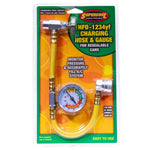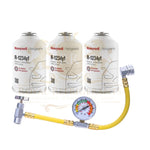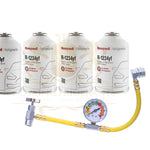You have no items in your shopping cart.

When your air conditioning (AC) unit struggles to keep your home cool, low refrigerant levels might be the culprit. Knowing how to fix low refrigerant in AC unit is essential to maintain optimal performance and comfort. The refrigerant is responsible for absorbing and releasing heat, allowing your AC to produce cool air. When levels are low, your system can't function efficiently, leading to higher energy bills and discomfort.
This guide will walk you through the signs of low refrigerant, why it occurs, and the steps to fix low refrigerant in an AC unit safely. At Royal Refrigerants, we offer high-quality refrigerant solutions to help maintain your HVAC systems and keep your environment cool and comfortable.
How to Identify Low Refrigerant in Your AC Unit
Understanding how to fix low refrigerant in AC unit starts with knowing the symptoms of low refrigerant levels. Identifying the problem early can prevent system damage and reduce repair costs.

Reduced Cooling Efficiency
One of the first signs of low refrigerant is a decline in cooling performance. If your AC unit runs continuously without reaching the desired temperature, it may not have enough refrigerant to effectively absorb and dissipate heat. This can result in longer cooling cycles and higher energy consumption.
Warm Air Blowing from Vents
When your AC unit blows warm or room temperature air instead of cool air, it often indicates low refrigerant levels. The refrigerant is crucial for heat exchange, and insufficient amounts can prevent the system from producing cold air.
Ice Buildup on Refrigerant Lines
Ice or frost forming on the refrigerant lines or evaporator coil is another sign of low refrigerant. When the refrigerant level is too low, the pressure drops, causing the coil temperature to fall below freezing and moisture in the air to freeze on the coil.
Why Do AC Units Lose Refrigerant?
Understanding the causes of low refrigerant can help you determine how to fix low refrigerant in AC unit effectively. Unlike fuel, refrigerant is not consumed during operation, so a drop in refrigerant levels usually indicates a problem.
Refrigerant Leaks
The most common cause of low refrigerant is a leak. Leaks can occur in the refrigerant lines, valves, compressor, or evaporator coil due to corrosion, wear and tear, or physical damage. Small pinhole leaks can lead to a gradual loss of refrigerant, affecting the AC unit’s performance over time.
Improper Installation or Servicing
If your AC unit was not installed properly, it might not have been charged with the correct amount of refrigerant. Similarly, if a technician did not seal the system properly during repairs or maintenance, it could lead to refrigerant loss. Ensuring that licensed professionals handle refrigerant servicing is vital to maintaining system efficiency.
Proper Ways to Take Care of Low Refrigerant Levels
Addressing low refrigerant issues requires a systematic approach and should ideally be performed by a licensed HVAC professional.

Here's how to fix low refrigerant in AC unit safely and effectively.
Turn Off the AC Unit
Before attempting any repairs, switch off your AC unit to prevent further damage. Running an AC with low refrigerant can cause the compressor to overheat, leading to expensive repairs.
Check for Refrigerant Leaks
The first step in fixing low refrigerant in an AC unit is to inspect for leaks. This can be done using UV dye, electronic leak detectors, or soap bubbles. Once the leak is identified, it must be repaired before recharging the system. Repairing refrigerant leaks involves replacing damaged components or sealing small leaks with approved sealants.
Recharge the AC Unit with the Correct Refrigerant
Once the leaks are repaired, the system needs to be recharged with the correct type of refrigerant. Using the wrong refrigerant type can damage the system and void the warranty. At Royal Refrigerants, we offer a range of high-quality refrigerants, including R410A, R134a, and R22 alternatives, to ensure efficient system performance.
The Importance of Using the Right Refrigerant
When learning how to fix low refrigerant in AC unit, it is crucial to use the correct refrigerant type to maintain system safety and efficiency.
Avoid Mixing Different Refrigerants
Mixing different types of refrigerants can cause chemical reactions, system inefficiency, and compressor damage. Always ensure your HVAC system is recharged with the specific refrigerant recommended by the manufacturer.
Choosing High-Quality Refrigerants
Using high-quality refrigerants from reputable suppliers like Royal Refrigerants ensures purity, performance, and compliance with environmental standards. Low-quality or counterfeit refrigerants can lead to clogs, system malfunctions, and safety hazards.
Additional Tips for Maintaining Refrigerant Levels in an AC Unit
Beyond knowing how to fix low refrigerant in AC unit, maintaining optimal refrigerant levels can prevent future issues and costly repairs.

Regular Maintenance and Inspections
Scheduling annual maintenance with a licensed HVAC technician is essential. They can check refrigerant levels, inspect for leaks, and service components to ensure your AC unit operates efficiently.
Monitor Your AC Unit’s Performance
If you notice cooling inefficiencies, strange noises, or frost buildup, it may indicate low refrigerant levels. Addressing these signs early can prevent more significant issues and maintain system efficiency.
FAQ
1. Can I fix low refrigerant in my AC unit myself?
No, only a licensed HVAC professional should handle refrigerant issues. Improper handling can lead to safety hazards and system damage.
2. How much refrigerant does my AC unit need?
The required refrigerant amount depends on your AC model. Typically, an AC unit may need 2-4 pounds of refrigerant, but always refer to the manufacturer’s guidelines.
3. How do I know if my AC unit is low on refrigerant?
Common signs include reduced cooling efficiency, warm air from vents, and ice buildup on refrigerant lines.
4. Is it safe to run an AC unit with low refrigerant?
No, running an AC unit with low refrigerant can damage the compressor and reduce efficiency, leading to higher repair costs.
5. How often do I need to add refrigerant to my AC unit?
An AC unit should not need refrigerant top-ups unless there is a leak. Regular maintenance helps ensure refrigerant levels remain stable.
Conclusion
Knowing how to fix low refrigerant in AC unit is essential for maintaining cooling efficiency and system longevity. When your AC unit shows signs of low refrigerant, addressing the issue with professional support and high-quality refrigerant is the best approach.
At Royal Refrigerants, we provide a wide range of refrigerant solutions to keep your HVAC systems running smoothly and efficiently. Whether you need R410A, R134a, or R22 alternatives, you can trust Royal Refrigerants for top-quality products and exceptional service. Contact us now for more information.
 English
English







